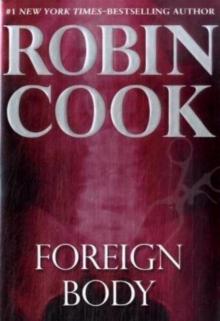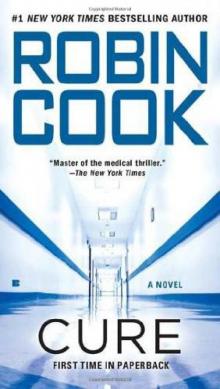- Home
- Robin Cook
Intervention sam-9 Page 6
Intervention sam-9 Read online
Page 6
“So the letter was saved for several hundred years. It was important, but then it became less so?”
“Yes,” Shawn agreed. “But it’s something I cannot explain.”
“What happened in AD 367, and what’s the theory of why these codices ended up being sealed in a jar and buried in the sand?”
“In AD 367 the Gnosticism movement had peaked and was on the decline, as ordered by the Orthodox Church. In compliance, the influential bishop of Alexandria, Athanasius, ordered the monasteries under his jurisdiction to dispose of all heretical writing, including the monastery that existed close to modern-day Nag Hammadi. It’s supposed that some of the monks rebelled at that monastery and instead of destroying the texts, hid them, with the intention of eventually retrieving them. Unfortunately for them, it didn’t happen, and their loss turned out to be our gain.”
“And you think this letter is a response to a letter that Basilides wrote to Saturninus.”
“There is no question in my mind, considering Saturninus’s syntax. He surely didn’t pull any punches in his description of his former boss and teacher, Simon the Magician. It is clear to me that Basilides had specifically asked if Saturninus thought Simon was divine, a true Christ in the footsteps of Jesus of Nazareth, and whether or not Simon possessed the Great Power as he claimed. Although Saturninus suggests that Simon himself thought he was either divine or was possessed of a spark of the divine, Saturninus surely didn’t. Saturninus clearly states that Simon’s magic was trickery, for which Saturninus and Simon’s other assistant, Menander, were largely responsible. Saturninus also says Simon was extremely jealous of the supposed curative power of the Apostles, especially Peter. This is a canonical fact. It appears in the Bible’s Acts of the Apostles, where it specifically states that Simon tried to buy Peter’s power.” Shawn paused to catch his breath but then added with a contemptuous chuckle, “Thanks to Saturninus and this letter, we know now that Simon didn’t give up after that initial rebuff.”
“What I find ironic is that we have this extraordinary historical information because of one person’s venality.”
“True,” Shawn agreed with a more open laugh. “But what I find ironic is that the same venality is quite likely going to vault me into the archaeological stratosphere. Belzoni, Schliemann, and Carter will have nothing on me.”
Sana couldn’t help but roll her eyes. Although Shawn’s seeming self-confidence had impressed her at the beginning of their relationship, she now found it puerile and self-absorbed, again suggesting Shawn harbored insecurity that she had not initially suspected.
Catching her reaction and misinterpreting it, Shawn added, “You don’t think this is going to be a big event? You’re wrong! This is going to be huge. And you know who I’m going to have the most fun breaking the news to?”
“I can’t imagine,” Sana said. She was more interested in continuing the discussion of the contents of the shocking letter, rather than its potential effect on Shawn’s career.
“His Eminence!” Shawn said with a touch of mock disdain. “James Cardinal O’Rourke, bishop of the Archdiocese of New York.” Shawn laughed, savoring the anticipation. “I can’t wait to drop in on my old Amherst College drinking buddy, now the most elevated member of the ecclesiastical establishment that I know and the one who’s forever lecturing me to mend my ways. I’m going to have a lot of fun rubbing his nose in this letter, proving to him that one of his uppity-up popes, believing he was infallible, was dead wrong. Mark my words!”
“Oh, please!” Sana scoffed. Too often, she’d witnessed her husband and the archbishop arguing uselessly into the wee hours of the morning, particularly about papal infallibility, after a dinner at the cardinal’s residence. “You two are never going to agree on anything.”
“This time, thanks to Saturninus, I’ll have proof.”
“Well, I hope I’m not there,” Sana remarked. She’d never enjoyed those evenings and lately had stopped participating. She’d asked if they could go out to a restaurant instead, which Sana thought would calm their behavior. But neither Shawn nor James were willing. They enjoyed their endless, seemingly acrimonious debates too much and didn’t want to be restrained.
Back at the beginning of their relationship, when Shawn had first told her about his long-standing friendship with the archbishop, she didn’t entirely believe him. The archbishop was the most powerful prelate in the country, if not the hemisphere. The man was a true celebrity. There was even talk that he might be destined for the Vatican.
Yet it wasn’t just their respective positions that made their friendship seem so unlikely. It was their personalities—Shawn the sophisticated extrovert, constantly seeking opportunities for real or imagined self-aggrandizement, James the ever-modest parish priest who had been waylaid by fate to assume more and more responsibilities for which he was ill prepared. What never ceased to amuse Sana was that these opposite personality styles were denied by the old friends themselves. Shawn would have none of James’s expressed modesty, accusing him of unbridled ambition fortified by exceptional pragmatism, shrewdness, and his ability to flatter. James considered Shawn’s bravado equally suspect, convinced Shawn was a deeply insecure person, a belief Sana was beginning to share. James never tired of constantly reminding Shawn that God and the Church were there to help him.
From Sana’s perspective, even the two men’s outward appearances argued against the chances that they would be friends. Shawn was a natural athlete who participated in varsity sports at Amherst. At six-foot-three and two hundred pounds, he was physically imposing and still fit from competitive tennis. James was short and plump, and now, often swathed head to toe in his scarlet robes of office, appeared decidedly elfin. On top of that, Shawn was black Irish, with thick, dark hair and strong angular features. James, on the other hand, had red hair and creamy, freckled, almost translucent skin.
What had drawn the two men together and had cemented their relationship, Sana was later to learn, was first circumstance and later a love of debate. It had started their freshman year when they had been made roommates. Joining them was another student who lived directly across the hallway. His name was Jack Stapleton, and as chance would have it, he too ended up living in New York City. So the Three Musketeers, as they were known in college, miraculously ended up in the same city even if they were worlds apart in their careers.
In contrast to James, Sana had met Jack Stapleton just twice. He seemed such a remarkably private person, she wondered how he’d gotten along with the others. Maybe his seemingly thoughtful, retiring nature and lack of self-reference had made him the glue that had held the group of friends together back in college.
“James is going to come unhinged,” Shawn continued, still chuckling to himself at the prospect. “And I’m going to love it. This is going to be my opportunity to put him on the hot seat, and is he going to squirm. I can’t wait to revisit the infallibility issue. In light of all the papal shenanigans during the Middle Ages and Renaissance, it’s an issue we’ve argued about hundreds of times.”
“What makes you so certain this is going to rank up with Carter’s discovery of King Tut’s tomb?” Sana questioned to refocus the discussion.
She wasn’t certain what the other two archaeologists Shawn had mentioned had discovered, although the name Schliemann was familiar.
“King Tut was an insignificant child ruler whose life was a mere blip in the sands of time,” Shawn snapped, “whereas the Virgin Mary was arguably the most important human to have lived, second only to her firstborn son. In fact, maybe they were equally important. She was the Mother of God, for chrissake.”
“No need to get yourself riled up,” Sana said soothingly. Of late Shawn often expressed irritation when he thought she was disagreeing with him in his area of expertise. The irony was that in no way did she question the historical importance of the Virgin Mary, especially in relation to the puny, teenage Tutankhamen, but Carter had unearthed a huge cache of treasure. So far, all Shawn had was three sheet
s of papyrus of unconfirmed authenticity that talked about the Virgin Mary’s remains. Yet Sana could see Shawn’s point from her own reaction. When Shawn had gotten to the section in Saturninus’s letter that involved the bones of the Virgin Mary, she had reacted as if Shawn had slapped her across the face.
“I’m not upset! I’m just surprised you don’t see the unbelievable importance of this letter.”
“I do! I do!” Sana insisted.
“What I think happened was Basilides asked Saturninus not just his opinion on Simon’s divinity but also whether Simon had written anything of substance and, if he had, where it might be. Maybe Basilides had his suspicions. That’s why I believe Saturninus described the Gospel of Simon along with the fact that he and Menander put it in the ossuary. I don’t believe Basilides had any idea about the Virgin Mary’s remains having been brought to Rome by Simon, nor did he care. He was interested in Simon’s theology.”
“What’s the actual definition of the word gospel?”
“It’s any message concerning Christ, which most people associate with the first four canonical books of the New Testament covering the teachings of Jesus Christ. More broadly, a gospel is any message of a religious teacher. That’s why it’s going to be both thrilling and instructive to learn if the Gospel of Simon is about Jesus Christ, Jesus Christ and Simon Christ together, or Simon Christ alone. I say it that way because most people think Christ was Jesus’ last name. It wasn’t. Christ was from the Greek kristos, meaning messiah, and it is where the word Christian was derived. If Simon considered himself a messiah, he could have very well referred to himself as Christ. Of course, we already know one thing: There was no resurrection associated with Simon. He stayed dead after he toppled off a tower in the Roman Forum at Nero’s behest, trying to prove his divinity, or at least his close association with divinity.” Sana glanced in Shawn’s eyes. She could read his mind. Obviously, he thought his chances of finding the Gospel of Simon were good, and she knew exactly why. Five years ago Shawn had prevailed upon James to use his influence with Pope John Paul II to obtain access to the necropolis under Saint Peter’s Basilica to carry out the definitive analysis of Saint Peter’s tomb. Over a period of six months, Shawn, along with a team of architects and engineers, had studied both the site and two thousand years of available papal records to write the definitive history of the tomb, including the 1968 discovery of a headless first-century male skeleton, heralded by Paul VI as the apostle’s remains. The result was that Shawn had become an expert on the gravesite, and if Saturninus and Menander had buried the Virgin Mary’s ossuary containing the Gospel of Simon in AD
65 where Saturninus claimed in the letter, Shawn would know where to look.
“I’ve heard of the Sadducees and the Pharisees, but never the Essenes or the Zealots,” Sana said, going back to the letter. “Who were these people Saturninus is talking about?”
“They were all separate Jewish sects, of which the Sadducees and Pharisees were far and away the most important because of their numbers. The Essenes were a small militant, ascetic, communal group who felt the Temple in Jerusalem had been defiled. Although there were Essene cells in most Palestinian cities, their strictest leaders and brethren moved out into the desert along the shores of the Dead Sea at Qumran. They were the transcribers of the Dead Sea Scrolls, as well as the people who hid them to keep them out of the hands of the Romans.
“The Zealots were more politically defined. Their primary goal was to rid Jewish lands of Roman oppressors, and the most fanatical members were called the Sicarii. To understand what was going on in the first century, you have to remember that most everyone wanted the Romans out of Palestine, except, of course, the Romans, and to a large degree that was what a lot of the contemporary messianic prophecy was all about.
The Jews expected a messiah to get rid of the Romans, which was one reason why a lot of Jews weren’t satisfied with Jesus being the Messiah. Not only did he not get rid of the Romans, he got himself crucified in the bargain.”
“Okay,” Sana said. “But why would the Zealots and the Essenes plot to steal the body of the Virgin Mary? That doesn’t make sense to me.”
“Saturninus doesn’t say specifically, but here’s what I think he is implying. When the Virgin Mary died in AD 62 as he says and was entombed in a cave on the Mount of Olives, perhaps even where her tomb is supposed to be today, some Zealots, probably the Sicarii, saw an opportunity to fan the fires of hatred of the Romans toward the Jews.
What they were trying to do was start a revolt, and they didn’t care which side was the instigator. Prior to that, the Sicarii had mostly concentrated on intensifying the hatred of the Jews toward the Romans, which is why they spent most of their time and energy assassinating those Jews who they thought were collaborating with or even just soft on the Romans. The rationale was to get the Jews to start the fight.
“Then the death of Mary offered something else. It offered an opportunity to put Roman frustration with the problem of religious strife over the top. You see, at that time in the mid-first century, Jews who had become followers of Jesus of Nazareth were considered Jews and not yet a new religion. Yet they didn’t get along with traditional Jews. In fact, they were constantly at each others’ throats over what the Romans considered ridiculously petty issues. On top of that, there was infighting among the Jewish Christians. It was pure religious anarchy, and the Romans were fit to be tied.”
“I still cannot understand the Virgin Mary’s role in all this.”
“Think of the Romans’ frustration. Saturninus mentions that the Romans thought they had taken care of the Jesus of Nazareth problem by crucifying Jesus. But they were wrong, because Jesus didn’t stay dead like all the other crucified supposed messiahs of the time, of which there were a number. Jesus came back in three days, which ended up, in retrospect, magnifying the problem rather than ending it. Saturninus implies that the Zealots counted on Mary’s disappearance in three days after her death to suggest that she too had defied death and had joined her son, reconfirming Jesus’ mission. The Zealots and the Sicarii stole the body of the Virgin, specifically on the third day, in the hope of terrifying the Romans into believing that there was possibly going to be another serious flare-up of religious fervor as followed Jesus’ resurrection, forcing them to crack down to prevent it. The idea was that a crackdown in such a tense environment would cause a cycle of violence, which would cause a harsher crackdown, and so on. As Saturninus mentions, he didn’t know if it was the disappearance of Mary’s body that did the trick, but soon after its theft, a cycle of violence did occur that grew progressively month by month. Within just a few years the tinderbox that was Palestine exploded into the climactic Great Revolt, with all the Jews uniting together to seize both Jerusalem and Masada from the Romans.”
“Do you think it would have been easy to steal the body of the Virgin?”
“Actually, I think it would have been. There seems to have been a surprising lack of interest in the Virgin Mary after the crucifixion, so that her death, according to Saturninus, in AD 62, drew little or no attention. None of the four Evangelists mentions much about her after Jesus’ death and resurrection, and Paul gives no indication whatsoever of a special place for her in the early Church. In fact, he mentions her only once in Galatians, and that was fleetingly, without even using her name. It wasn’t until toward the end of the first century that Mary began getting more recognition. Today there is no question of her importance, which is why I believe this letter is so significant.”
“I didn’t get the impression from Saturninus’s letter that Simon Magus had any connection with the initial theft of Mary’s remains.”
“Nor did I. My sense is that his interest was driven by his desire to secure for himself the curative power related to Jesus of Nazareth, and he didn’t share the political interests of the Zealots. Saturninus doesn’t mention how Simon learned that the Essenes had hidden the body in one of the Qumran caves, nor does he say how he managed to gain control
of the bones. Perhaps by then no one cared. Simon was disappointed the remains didn’t have the power to heal, which was obviously his reason to gain possession of them, and it was only after the fact that he got the idea to follow Peter, first to Antioch, and then Rome, with the plan to trade them for Peter’s curative power.”
“But Peter rebuffed him again.”
“Apparently so, and according to Saturninus, with equal passion as when he had offered silver.”
“Why do you think Saturninus and Menander decided to bury Mary’s bones with Peter?”
“I believe for the reason he states in the letter. They were both impressed with Peter’s ability to cure by laying on of hands. We know they were impressed, since ultimately both became Christians, and Saturninus became a bishop of a major Roman city.”
“I wonder what happened to Simon’s remains. It would have been ironic if they ended up with Peter as well.”
“Indeed,” Shawn said with a smile. “But I doubt it sincerely. Saturninus surely would have said if he and Menander had done it.”
“So, what are your plans?” Sana questioned. “Let me guess. You want to go to Rome and see if this ossuary Saturninus described is where he said he and Menander put it?”
“Exactly,” Shawn said eagerly. “Apparently, just around the time Simon died during his attempt to rise up to heaven, Peter must have been martyred. With Peter’s followers building him an underground tomb, Saturninus and Menander would have had a convenient opportunity to join Mary’s ossuary with one of her son’s closest apostles.
Frankly, I think it was a very respectful gesture on their part, and it certainly suggests that they at least held Mary in high regard.”
“I didn’t understand the part of the letter describing where they put it,” Sana said. “Do you?”
“I do. The tomb was a barrel vault, comprised of two parallel foundation walls holding up a vault. To build such a tomb, a rather large hole has to be excavated so that the walls can be put up. Saturninus says that they placed the ossuary at the base of the north wall outside of the tomb, approximately in the middle, and covered it with dirt. That is consistent with the facts, because the foundation walls of Peter’s tomb run east-west.

 Shock
Shock Mutation
Mutation Chromosome 6
Chromosome 6 Brain
Brain Intervention
Intervention Invasion
Invasion The Legend of Parzival: The Epic Story of His Quest for the Grail
The Legend of Parzival: The Epic Story of His Quest for the Grail Acceptable Risk
Acceptable Risk Cell
Cell Fever
Fever Death Benefit
Death Benefit Contagion
Contagion Mindbend
Mindbend Coma
Coma Vital Signs
Vital Signs Harmful Intent
Harmful Intent Critical
Critical Foreign Body
Foreign Body Marker
Marker Blindsight
Blindsight Terminal
Terminal Sphinx
Sphinx Fatal Cure
Fatal Cure Host
Host Charlatans
Charlatans Crisis
Crisis Vector
Vector Toxin
Toxin Abduction
Abduction Viral
Viral Pandemic
Pandemic Outbreak
Outbreak Vector js&lm-4
Vector js&lm-4 Godplayer
Godplayer A Brain
A Brain Year of the Intern
Year of the Intern Outbreak dmb-1
Outbreak dmb-1 Cure
Cure Mortal Fear
Mortal Fear The Legend of Parzival
The Legend of Parzival Vital Signs dmb-2
Vital Signs dmb-2 Cure (2010) sam-10
Cure (2010) sam-10 Blindsight sam-1
Blindsight sam-1 The Year of the Intern
The Year of the Intern Intervention sam-9
Intervention sam-9 Foreign Body sam-8
Foreign Body sam-8